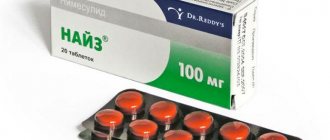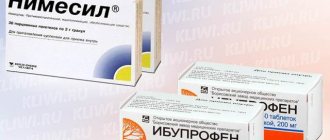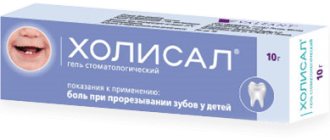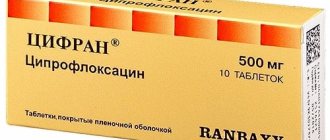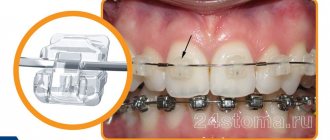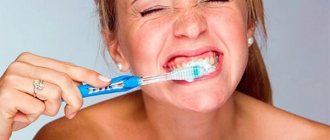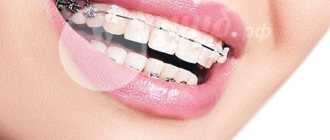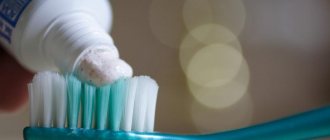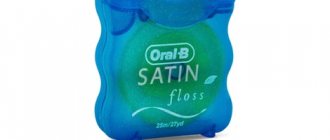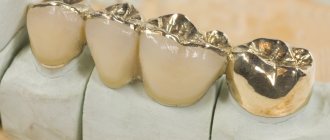Will it help?
Of course, before taking painkillers for a toothache, you should assess the degree of pain and think about the potential consequences of taking medications. In fact, according to statistics, very few people think about these aspects as soon as they experience pain in the oral cavity.
The most important fact is that relieving toothache with tablets will only be a temporary solution. This approach will help alleviate the general condition, but only for a certain time.
It should also be noted that tooth pain is often accompanied by concomitant symptoms, which manifest themselves in inflammation of the gums, cheek area, increased body temperature and a feeling of general malaise. Many of the tablets help relieve secondary manifestations, but have no effect on the cause.
This is why in most cases a visit to the dentist will still be required. After all, the painkiller will simply reduce the level of pain, but not for long. Moreover, in many situations the ongoing disease will only gain momentum and the pain will increase. Therefore, there is no point in enduring without visiting a doctor for a long period with persistent toothache.
Types of strong painkillers for tooth pain
For toothache, different types of painkillers can be used. Let's list:
- Tablets are used to influence the pain epicenter. They can dull the discomfort for several hours.
- The powder is gentle on the gastrointestinal tract and has anti-inflammatory and antipyretic effects.
- Toothpaste helps with increased sensitivity of tooth enamel. That is, if there is caries, pain relief will not occur. In the first case, it is enough to brush your teeth regularly.
- The gel is also able to temporarily relieve toothache due to its local anesthetic effect.
Let's go through the list
This material is not an advertisement for any products, so we will list the most suitable solutions in tablets for toothache in alphabetical order:
- Analgin.
- Ibuklin.
- Ketanov.
- Ketorol.
- Moment.
- Nise.
- Nimesil.
- Nurofen (ibuprofen and drugs identical to this group).
- Sanaprox.
- Tempalgin.
Ketanov is considered one of the most suitable options when asking what you can drink for toothache. It has a sufficient speed of impact, that is, fast, and at the same time effective. In some cases, such tablets help relieve even severe pain. But you should remember about the frequency of administration and dosages.
Nurofen not only helps relieve pain, but also has an anti-inflammatory and antipyretic effect on the entire body. You should be aware that some of the modifications of these toothache tablets contain a potent substance in the form of codeine. We are talking about variations of Nurofen Plus and Nurofen Plus N. It will also enhance the analgesic effect. The classic version can be used to relieve toothache in both adults and children.
A simple option with classic toothache tablets in the form of Analgin is also popular in the fight against this disease. The main substance here is sodium metamizole, which, due to its acidic structure, has a negative effect on enamel. For this reason, if there is damage in the latter, the area of carious lesions may increase. But if the filling falls out or is chipped, it will be effective.
NSAIDs and triptans for migraine: separately or together?
According to international recommendations, treatment of a migraine attack in most patients should begin with the use of a non-narcotic analgesic or non-steroidal anti-inflammatory drug (NSAID). Placebo-controlled studies in migraine have been conducted for acetylsalicylic acid (ASA) [1–4], ibuprofen [5,6], diclofenac [7–9], metamizole [10], phenazone [11], tolfenamic acid [12], paracetamol [13]. It has been shown that the combination of ASA with paracetamol and caffeine is highly effective for migraine and has advantages over separately used components [14–16]. Intravenously administered ASA relieves migraine attacks better than subcutaneously administered ergotamine [17]. The combination of ASA with metoclopramide was as effective as sumatriptan [18]. Effervescent ASA (1000 mg), ibuprofen (400 mg) and sumatriptan (50 mg) were equally effective for migraine [19,20]. A placebo-controlled study showed that the potassium salt of diclofenac in sachet form (50 and 100 mg) was as effective as sumatriptan (100 mg) in relieving migraine [9]. The selective COX type 2 inhibitor valdecoxib (20–40 mg) also reduced migraine pain [21]. The European Federation of Neurological Societies (EFNS) recommends the use of NSAIDs for the treatment of migraine, the effectiveness of which has been proven in randomized, double-blind, placebo-controlled studies [22] (Table 1). For the relief of migraine, NSAIDs with rapid accumulation in plasma (Tmax) and a short half-life (T1/2) are primarily recommended, which ensures the rapid development of analgesia and the safety of the drug upon repeated use. For this purpose, drugs have been created with modified physicochemical and pharmacokinetic properties, thanks to which rapid analgesia can be achieved (Table 2). Diclofenac, ketoprofen, ketorolac and ibuprofen are most commonly used for the treatment of migraine, since their analgesic activity is higher than that of other NSAIDs [23]. For example, after intramuscular administration of the sodium salt of diclofenac (75 mg) or after ingestion of a sachet of potassium salt of diclofenac (Voltaren-Rapid 50 mg), analgesia occurs on average after 15 minutes. The anise and menthol flavors included in the sachet improve the organoleptic properties of the drug and reduce nausea. A large randomized trial showed that in the treatment of many migraine attacks, the effectiveness of diclofenac potassium salt against headache was comparable to sumatriptan, and associated nausea and vomiting decreased significantly more often than with triptan [9] (Table 3). The clinical effectiveness of triptans for migraine has been demonstrated in large placebo-controlled studies, which are reflected in several published comparative analyses. Triptans are effective during any period of a migraine attack, but their early use increases the effectiveness of treatment [3,15,18]. The use of triptans in the aura phase before the onset of headache is ineffective. The accumulated experience of long-term use of triptans indicates that they should not be used more than 9 days a month, as this significantly increases the risk of transition from episodic migraine to chronic and contributes to the development of abusive headaches. Differences in the clinical effectiveness of triptans are determined not only by the pharmacological parameters of the drugs, but also by the individual sensitivity of the patient. In this regard, if there is no effect from using one triptan, you should not refuse to use another next time. An analysis of 53 studies shows that the effectiveness of triptans taken orally is approximately the same, and only eletriptan at a dose of 80 mg is more effective both overall and in the first 30 minutes. after taking the drug. A comparative analysis of the use of various dosage forms of triptans shows that intranasal and rectal use of these drugs is especially promising for concomitant vomiting. The European Federation of Neurological Societies (EFNS) recommends the use of triptans for the treatment of migraine, the effectiveness of which has been repeatedly proven in randomized, double-blind, placebo-controlled studies [22] (Table 4). Recently, the possibility and feasibility of the combined use of NSAIDs and triptans for the treatment of migraine has been actively discussed and studied. The results of a 2005 study showed that a fixed combination of sumatriptan (50 mg) and naproxen sodium (500 mg) was more effective in relieving migraine attacks than monotherapy with these drugs [24]. Headache relief at 2 hours was significantly greater in patients receiving the fixed combination of sumatriptan and naproxen (65%) than in patients receiving sumatriptan (49%) or naproxen (46%) monotherapy (p<0.01). Complete headache relief in this study was reported in 29% of those taking the fixed combination of sumartriptan and naproxen, 25% of those taking sumatriptan and 17% of those taking naproxen (p<0.001). The comparative effectiveness of rizatriptan (10 mg) and its combination with rofecoxib (25 mg) was studied in 56 patients with migraine. This open-label study showed no statistically significant difference between treatment groups in pain relief and associated symptoms of nausea, vomiting, photophobia, and sound sensitivity. However, the number of patients with headache relapses after its successful relief was significantly (p<0.001) lower in the group of patients taking a combination of rofecoxib and rizatriptan (20%) than in the group taking rizatriptan alone (53%). The authors found no differences between groups in the incidence of side effects [25]. Another study examined the comparative effectiveness of rizatriptan (10 mg) and its combination with rofecoxib (50 mg) and tolfenamic acid (200 mg) in the treatment of six consecutive migraine attacks in 45 patients. Complete pain relief after 2 hours was recorded in 37.9% of patients receiving rizatriptan monotherapy, 40.6% receiving combination treatment with rizatriptan and tolfenamic acid, and 62.9% receiving combination treatment with rizatriptan and rofecoxib. However, 4 hours after the treatment, there were no differences between the groups. The incidence of recurrence of migraine after successful relief was lower with the combined use of a triptan with NSAIDs (15.4% for the combination with rofecoxib and 7.7% for the combination with tolfenamic acid) than with rizatriptan monotherapy (50%) [26]. In 2007, a study was completed that confirmed the high effectiveness of the combination of sumatriptan (85 mg) and naproxen (500 mg) in the treatment of migraine attacks [27]. The authors of these and other studies suggest that the benefit of combining a triptan and an NSAID is due to the complex effects of these drugs on various mechanisms of migraine pathogenesis, as well as differences in the pharmacokinetics of these classes of drugs. The advisability of using NSAIDs during the aura phase, when triptans are not recommended, or early joint use in patients with severe migraine is emphasized. Thanks to the combined use of NSAIDs and triptans, it is possible to speed up the time of onset of analgesia, as well as prevent relapse of migraine (Fig. 1). The accumulated data allows us to formulate a number of provisions that will help increase the effectiveness of treatment of a migraine attack: 1. NSAIDs are effective for migraine and can be recommended for most patients as first-choice drugs. Administration of NSAIDs intramuscularly or in the form of a modified sachet provides a more rapid development of analgesia. If the patient cannot distinguish a migraine attack from a tension headache, then he should take an NSAID. 2. Triptans are highly effective treatments for migraine. They act on the main links in the pathogenesis of migraine and are not analgesics. They should not be taken during a migraine aura. Triptans are the first choice in patients who do not respond to NSAID therapy. There is individual sensitivity of patients to one or another triptan. 3. The combined use of NSAIDs and triptans can more effectively relieve headaches and prevent migraine relapse. 4. If nausea and vomiting are severe, NSAIDs and triptans should be avoided by mouth. Intranasal, rectal or intramuscular routes of administration are preferred.
References 1. Chabriat H, Joire JE, Danchot J, Grippon P, Bousser MG. Combined oral lysine acetylsalicylate and metoclopramide in the acute treatment of migraine: a multicentre double–blind placebo–controlled study. Cephalalgia 1994; 14: 297–300. 2. Nebe J, Heier M, Diener HC. Low-dose ibuprofen in self-medication of mild to moderate headache: a comparison with acetylsalicylic acid and placebo. Cephalalgia 1995; 15:531–535. 3. Tfelt–Hansen P., Henry P., Mulder LJ, Scheldewaert RG, Schoenen J., Chazot G. The effectiveness of combined oral lysine acetilsalicylate and metoclopramide compared with oral sumatriptan for migraine // Lancet. – 1995. – Vol. 346. – P.923–926. 4. Diener HC, Bussone G, de Liano H, et al. Placebo controlled comparison of effervescent acetylsalicylic acid, sumatriptan and ibuprofen in the treatment of migraine attacks. Cephalalgia 2004; 24:947–954. 5. Havanka–Kanniainen H. Treatment of acute migraine attack: ibuprofen and placebo compared. Headache 1989; 29:507–509. 6. Kloster R, Nestvold K, Vilming ST. A double–blind study of ibuprofen versus placebo in the treatment of acute migraine attacks. Cephalalgia 1992; 12: 169–171 7. Karachalios GN, Fotiadou A, Chrisikos N, Karabetsos A, Kehagioglou K. Treatment of acute migraine attack with diclofenac sodium: a double-blind study. Headache 1992; 32:98–100. 8. Dahlof C., Bjorkman R. Diclofenac–K (50 and 100 mg) and placebo in the acute treatment of migraine. Cephalalgia 1993; 13: 117–123. 9. The Diclofenac–K/Sumatriptan Migraine Study Group. Acute treatment of migraine attacks: efficacy and safety of a nonsteroidal antiinflammatory drug, diclofenacpotassium, in comparison to oral sumatriptan and placebo. Cephalalgia 1999; 19: 232– 240 10. Tulunay FC, Ergun H, Gulmez SE, et al. The efficacy and safety of dipyrone (Novalgin) tablets in the treatment of acute migraine attacks: a double–blind, crossover, randomized, placebo–controlled, multi–center study. Function Neurol 2004; 19: 197–202 11. Goebel H, Heinze A, Niederberger U, Witt T, Zumbroich V. Efficacy of phenazone in the treatment of acute migraine attacks: a double-blind, placebo-controlled, randomized study. Cephalalgia 2004; 24: 888–893 12. Myllyla VV, Havanka H, Herrala L, et al. Tolfenamic acid rapid release versus sumatriptan in the acute treatment of migraine: comparable effect in a double–blind, randomized, controlled, parallel–group study. Headache 1998; 38:201–207. 13. Lipton RB, Baggish JS, Stewart WF, Codispoti JR, Fu M. Efficacy and safety of acetaminophen in the treatment of migraine: results of a randomized, double-blind, placebo-controlled, population-based study. Arch Intern Med 2000; 160:3486–3492. 14. Lipton RB, Stewart WF, Ryan RE, Saper J, Silberstein S, Sheftell F. Efficacy and safety of acetaminophen, aspirin, and caffeine in alleviating migraine headache pain—three double-blind, randomized, placebo-controlled trials. Arch Neurol 1998; 55: 210–217 15. Diener HC, Pfaffenrath V, Pageler L. The fixed combination of acetylsalicylic acid, paracetamol and caffeine is more effective than single substances and dual combination for the treatment of headache: a multi–centre, randomized, double– blind, single-dose, placebo-controlled parallel group study. Cephalalgia 2005; 25: 776–787. 16. Goldstein J, Silberstein SD, Saper JR, Ryan RE Jr, Lipton RB. Acetaminophen, aspirin, and caffeine in combination versus ibuprofen for acute migraine: results from a multicenter, double–blind, randomized, parallelgroup, single–dose, placebo–controlled study. Headache 2006; 46: 444–453 17. Limmroth V, May A, Diener HC. Lysine–acetylsalicylic acid in acute migraine attacks. Eur Neurol 1999; 41:88–93. 18. Tfelt–Hansen P., Henry P., Mulder LJ, Scheldewaert RG, Schoenen J., Chazot G. The effectiveness of combined oral lysine acetilsalicylate and metoclopramide compared with oral sumatriptan for migraine // Lancet. – 1995. – Vol. 346. – P.923–926. 19. Diener HC, Eikermann A, Gessner U, et al. Efficacy of 1000 mg effervescent acetylsalicylic acid and sumatriptan in treating associated migraine symptoms. Eur Neurol 2004; 52:50–56 20. Lampl C, Voelker M, Diener HC. Efficacy and safety of 1000 mg effervescent aspirin: individual patient data meta–analysis of three trials in migraine headache and migraine accompanying symptoms. J Neurol 2007; 254:705–712. 21. Kudrow D, Thomas HM, Ruoff G, et al. Valdecoxib for treatment of a single, acute, moderate to severe migraine headache. Headache 2005; 45: 1151–1162 22. Evers, S., Afra, J., Frese, A., Goadsby PJ, Linde M., May A. and Sandor PS EFNS guideline on the drug treatment of migraine – revised report of an EFNS task force. European Journal of Neurology 2009, 16, 968–981 23. Ignatov Yu.D., Kukes V.G., Mazurov V.I. Clinical pharmacology of nonsteroidal anti-inflammatory drugs, M., GEOTAR, 2010,–258 C 24. Smith TR, Sunshine A, Stark SR, et al. Sumatriptan and naproxen sodium for the acute treatment of migraine. Headache 2005; 45:983–991. 25. Krymchantowski AV, Barbosa JS. Rizatriptan combined with rofecoxib vs. rizatriptan for the acute treatment of migraine: an open label pilot study. Cephalalgia 2002;22:309–12. 26. Krymchantowski AV, Bigal ME. Rizatriptan versus rizatriptan plus rofecoxib versus rizatriptan plus tolfenamic acid in the acute treatment of migraine. BMC Neurol 2004;4:10 27. Brandes JL, Kudrow D, Stark SR, et al. Sumatriptan–naproxen for acute treatment of migraine: a randomized trial. JAMA 2007; 297:1443–1454
About contraindications
Any doctor will tell you that any painkillers for toothache also have a negative effect on the body. This is due to the fact that they involve the functioning of the gastrointestinal tract, kidneys, liver, cardiac and nervous systems. But side effects are observed when pills and other types of drugs are taken incorrectly or when treatment regimens are not followed.
Main contraindications for toothache tablets:
- individual intolerance;
- pregnancy;
- lactation period;
- ulcer;
- heart failure;
- kidney or liver problems;
- asthma;
- problems with the circulatory system;
- childhood.
In fact, the body can react individually to the action of substances, so before taking any painkillers you should read the instructions, and, if possible, also consult a specialist.
Nise
The active substance is nimesulide . Available in the form of tablets and gel. It has anti-inflammatory, antipyretic and analgesic effects. The analgesic effect is observed 15 minutes after administration. The maximum concentration of the substance in the blood plasma is observed after 30 minutes.
The drug is able to inhibit the formation of enzymes that destroy cartilage tissue. It also reduces the release of histamine and eliminates bronchospasm. Therefore, it can be used for bronchial asthma.
The maximum concentration of the drug in the body is observed after 2 hours . Penetrates well into body tissues and fluids. When using the gel, the components penetrate well into muscle and joint tissue. It is found in the blood in small doses. A persistent therapeutic effect is observed after 4 weeks of regular use. Indications for use of tablets:
- Arthritis.
- Osteoarthritis.
- Osteochondrosis.
- Thrombophlebitis.
- Toothache and headache.
- Fever
Indications for use of the gel:
- Rheumatoid and psoriatic arthritis.
- Osteochondrosis.
- Lumbago syndrome.
- Bursitis.
- Sciatica.
- Sprains and bruises.
Contraindications are:
- Exacerbation of peptic ulcer disease.
- Allergic reaction to the components of the drug.
- Pregnancy and breastfeeding.
- Children under 12 years old.
- Liver and kidney failure.
It should be taken with caution in case of diabetes mellitus, hypertension and lupus erythematosus. After taking the pills, drowsiness , so you should refrain from driving.
Adults and children over 12 years of age are recommended to take 1 tablet 2 times a day. It is better to take before meals with water. If discomfort occurs, tablets are taken at the end of the meal. The maximum dose per day is 400 mg . If renal function is impaired, the dose is reduced. If, while taking the tablets, symptoms associated with liver dysfunction appear, the drug is discontinued. After two weeks of use, it is necessary to do a biochemical blood test to check liver function indicators.
The gel has a pronounced analgesic effect. It is applied to the painful area 2-3 times a day, in a thin layer, without rubbing. The amount of gel may vary depending on the size of the affected area. Do not apply under bandages or on areas with damaged skin.
